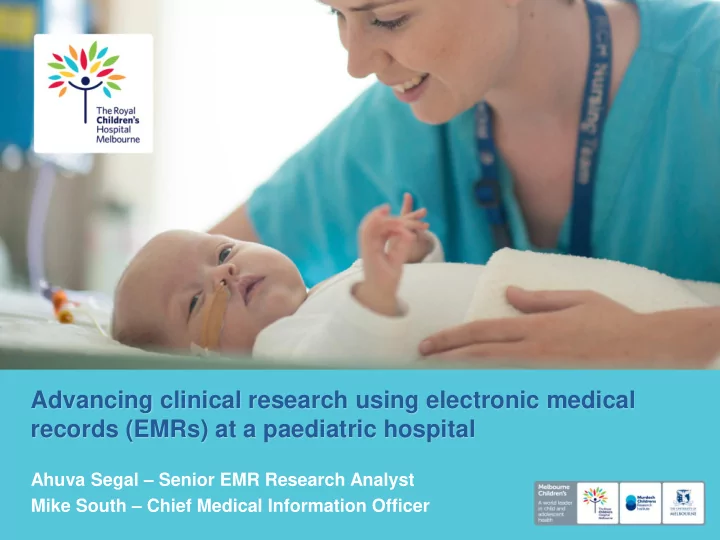

Advancing clinical research using electronic medical records (EMRs) at a paediatric hospital Ahuva Segal – Senior EMR Research Analyst Mike South – Chief Medical Information Officer
Outline • Overview of RCH EMR Project • Making our EMR work for researchers • Discuss lessons learned • Future plans • Questions
Royal Children’s Hospital • 340 beds (plus ~35 Hospital in the Home) • Inpatient admissions 48,000 • Emergency Department presentations 80,000 • Ambulatory attendances 285,000 • Operations 19,000
Melbourne Children’s
It was hoped that the EMR would: • Help deliver evidence-based in the safest possible care • Standardise practice to reduce variation/duplication • Be easy to use • Reduce waste and increase efficiency • Increase family engagement • Support research (from Go-Live)
Project Implementation Single, comprehensive, enterprise-wide EMR
Project implementation Clinical transformation project, not an IT project • Clinical systems replaced or integrated • Data migrated from legacy systems • New devices – COWs, handheld devices • Training – 3800 staff (~300 research staff)
Research and the EMR • Use data in real-time to embed evidence-based research at POC • Use data to inform research/QI projects • Support research practices
Epic and Research • Governed by: – Health Records Act – Privacy Act • Harsh fines for breaching patient privacy
Epic and Research • Risk minimisation strategies: – Honorary appointments – HREC Approval – Break-the-glass (BTG)
Break the Glass (BTG) • Epic security feature which controls access to patient information • Non-RCH research staff will BTG to gain access to patient records
Patient-study association
RCH Research Studies • 304 studies currently built in the EMR • 195 interventional / 109 observational studies – 3054 patients - interventional studies – 6442 patients - observational studies Only a small subset of EMR based research
CTMS • EMR is not a Clinical Trial Management System (CTMS) • Allows for representation of research on the Melbourne Children’s Campus
Adverse Event Reporting
Research-billable items
Making the EMR work for research
Reports – Bowel and Bladder Dysfunction Project component Retrospective audit Baseline survey Patient registration EMR Report using Screening method Referral system multiple criteria Scanned medical record Number to screen 1489 638 Number eligible 281 352 Time period 3 months 3 months Duration of screen 7 months 3 days Year of data collection 2016 2017 Personnel 1 PhD student, full-time 2 medical students
SlicerDicer
SlicerDicer
Research Best Practice Advisories (BPAs ) • Pop up seen by clinicians and other staff to drive better care and decision making • Built to be triggered by study-specific criteria
PICNICC • Low risk fever and neutropenia observational study (PICNICC) • Patients from RCH had blood samples collected for RNA sequencing • Started with making tissue bank order available in ED • Changed to a BPA in March, 2017
Criteria # Staff member is ED Doctor/NP 1 Patient is in ED <4 hrs 2 Patient is associated to the Tissue Bank Study 3 Patient does not already have a tissue bank order for that encounter 4 Reason for attendance is FEVER - HAEM/ONC PT 5 Patient is on oncology plan 6 Fever > or = 38.0 documented during ED stay 7 Reason for attendance is fever 8 Patient does not already have an unsigned tissue bank order 9 Checks to see sample wasn’t collected past 24 hours (i.e., frequent flyers) 10 Patient is on AALL0932 or ALL1131 Maintenance Protocols. 11 Works together with Criteria 12. Outside of 9-5 Weekdays, patients on the Maintenance protocol will not have 12 samples collected. During 9-5 weekdays the BPA will fire even for patients on these protocols. Excludes patients with a problem on their problem list of Aplastic Anemia 13 LOGIC: 1 AND 2 AND 3 AND 4 AND 10 AND 13 AND (11 OR 12) AND (5 OR (6 AND 7) OR (6 AND 8)) AND NOT 9
PICNICC
PICNICC 70 60 % suitable samples collected 50 40 30 20 10 0 No EMR Go-Live BPA Revised BPA Time point
Suggested Patient Instructions
Research documentation
SmartForms
Patient-Entered Questionnaires
Health Services Research Oral antibiotics for fever CXRs in asthma CXRs and bronchodilators/steroids in bronchiolitis PPIs in gastro-oesophageal reflux AXR in nonspecific abdo pain
Clinical Research
Future projects
Melbourne Children’s Centre for Health Informatics Health Services Service Clinical Informatics Research Delivery Digital Health Quality Improvement Population Health Informatics Digital Clinical Care Technologies and Artificial Data Linkage Electronic Intelligence Medical GenV Record LifeCourse Genomics Clinical trials -Omics Epidemiology Cohort studies Bioinformatics Biostatistics Bioinformatics Biostatistics and Epidemiology
Melbourne Precinct Project
REDCap Integration
Adverse Event Reporting Part 2
Some users were very reluctant to give up specialised functionality • Dedicated EMR team – included RCH clinicians and researchers • Strong engagement is required Many of the challenges relate to the people and not the system!
• Work on data governance early • Set research as an important priority • Don’t leave research in the wilderness – incorporate into core functions • Work doesn’t stop with Go Live – need to work hard to keep it on the agenda
• Rubbish in, rubbish out • There are many tools for data entry – the content is not necessarily readily available for analysis • Discrete items are easier than free text but still need to be configured to save to database fields • We tried to provided self-service data access where possible • Allow resources for training relevant staff in the use of these tools
Acknowledgements • EMR Team • Murdoch Children’s Research Institute • Children’s Hospital Foundation • Victorian Government (Department of Health) • Epic Application Managers and Technical Support • Patients and their families • Hospital staff • Research assistants, coordinators and nurses • RCH Office of Ethics and Governance …and the many more who contributed to the EMR implementation.
What questions do you have?
Recommend
More recommend